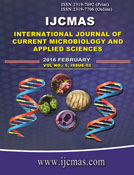


 National Academy of Agricultural Sciences (NAAS)
National Academy of Agricultural Sciences (NAAS)

|
PRINT ISSN : 2319-7692
Online ISSN : 2319-7706 Issues : 12 per year Publisher : Excellent Publishers Email : editorijcmas@gmail.com / submit@ijcmas.com Editor-in-chief: Dr.M.Prakash Index Copernicus ICV 2018: 95.39 NAAS RATING 2020: 5.38 |
1Department of Microbiology, SHKM GMC Mewat, Haryana, India
2Department of ENT, SHKM GMC Mewat, Haryana, India
Blood streams infections are important cause of sever morbidity and mortality of patients. The study aimed to find out aerobic bacteriological profile and evaluate emergence of ESBL among multi drug resistant strains. 571 bacterial isolates were subjected to antibiotic susceptibility test for common antibiotics used to treat septicaemia and double disc and Amp C disc test for detection of ESBL and Amp C β lactamases among multidrug resistant strains. In our study maximum patients were from paediatric ward, female patients were more than male but difference is insignificant. There were Pseudomonas (19%), Staphylococcus aureus (12.9%), Klebsiella (12.1%), E. coli (11%), CONS (11%), Enterobacter (8.8%), Citrobacter (8.2%), Acinetobacter (7%), Candida (4%), Enterococcus (2.4%), and salmonella typhi (1.9%). Gram positive cocci were highly sensitive to vancomycin and teicoplanin and Gram negative bacilli were highly sensitive to Imepenem and quinilones. 21.1% of Enterobacteriaceae produced ESBL, 6.4% produced Amp C β lactamase and 6.3% produced both type of β lactamases. Two isolates of pseudomonas were MBL positive. 23% organism were multi drug resistant (MDR) in all isolates. There was no PDR found in our study. In gram positive cocci 53% were MRSA and 43% were MRCoNS. Significant difference found between antibiotic susceptibility of ESBL and non ESBL strain. Data of our study provided much needed information on prevalence of antimicrobial resistance amongst pathogens causing blood stream infections in Mewat region. Multidrug resistant organism can result in treatment failure. Therefore it is recommended that any ESBL producing organism according to national committee for clinical laboratory standards (NCCLS) can be reported as resistant to all extended spectrum β lactam antibiotics regardless of susceptibility test results
 |
 |
 |
 |
 |